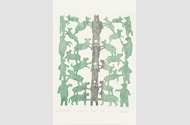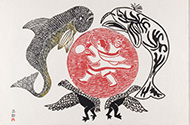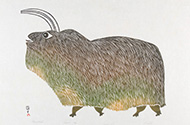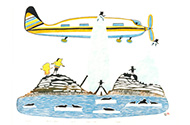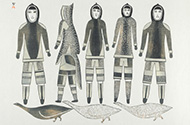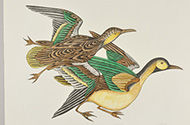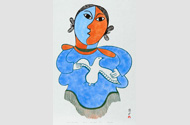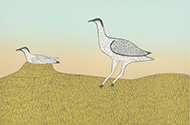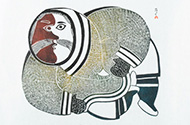Audio
1970s The Years of Expansion
Things looked bright as the West Baffin Eskimo Co-operative started its second successful decade of operation. International exhibitions featuring Cape Dorset prints, increasing sales and scholarly books helped make Inuit prints a shared part of Canada’s cultural fabric—Canada Post even issued a 6-cent stamp in 1970 featuring Kenojuak Ashevak’s famous Enchanted Owl, a print from 1960.
Printmakers at the West Baffin Eskimo Co-operative studio continued to expand their artistic horizons. In 1972 with the assistance of Lowell Jones, Robert Patterson, Charlie Patcher and Avrom Isaacs, Cape Dorset artists received their first lithography press and began to explore this new print technique.
Nova Scotia artist Wallace Brannen worked in the community starting in 1974 to teach various lithographic techniques and Cape Dorset artists commercially released their first lithographs in 1975, complementing their existing stonecut, stencil and engraving prints.
The original copperplate engraving technique of the 1960s was supplanted by etchings and aquatint, with Kooyoo Simiga, Udluriak Pudlat and Oqsuraliq Ottochie as the resident etching staff. Typographer Will Hudson, from Coachhouse Press in Toronto, introduced a short-lived but exciting typographic project in 1972.
In addition to these technical developments, artists continued to explore new subject matter: in 1976 Pudlo Pudlat released his lithograph Aeroplane, the first of his many prints to depict airplanes, helicopters and other modern accoutrements in the “new North.”
Other artists continued to refine more eloquent ways of expressing traditional subjects, such as Arctic animals, myths and history. The North was changing, and so were Cape Dorset prints.
Through the 1970s, the sizes of annual collections grew from roughly 50 to over 110 different prints per year. The Cape Dorset studio introduced special, limited-release collections and commissions, most notably for the World Wildlife Fund, the National Museum of Man, and other private corporations and galleries.
Not surprisingly, the number of printmakers increased dramatically during this decade. Added to the list of stone- and stencil-printers from the 1960s (such as Eegyvudluk Pootoogook, Iyola Kingwatsiak, Kananginak Pootoogook, Lukta Qiatsuk and Timothy Ottochie) was Laisa Qudjuakjuk, Ningeochiak Pudlat, Pee Mikkigak, Qabavoak Qatsiya and Saggiaktok Saggiaktok. In the new lithography studio, the active printmakers included Aoudla Pudlat, Ilakimi Nungusuituq, Johnny Manning, Keakshuk Niviaqsi, Kudlua Simionie, Kuyu Ragee, Pitseolak Niviaqsi and Pootoogook Kiakshuk.

